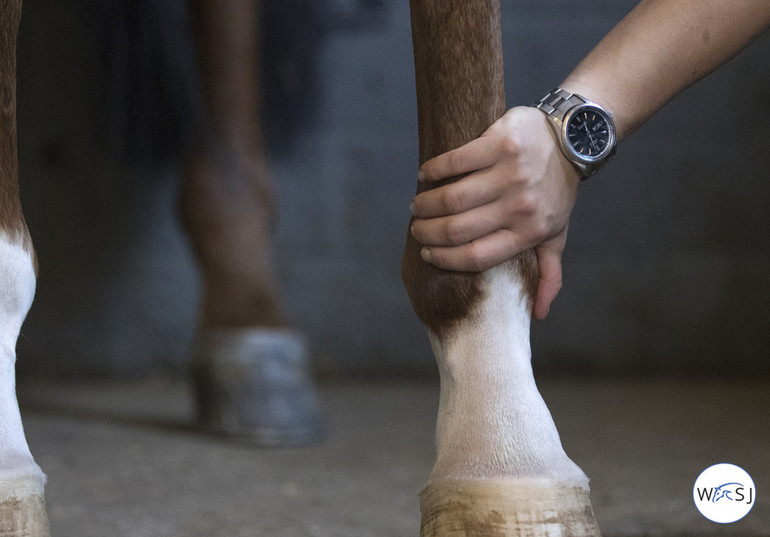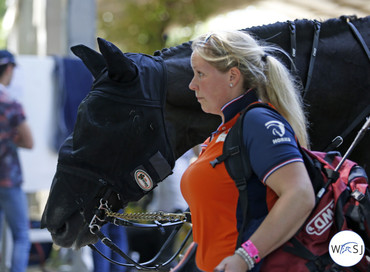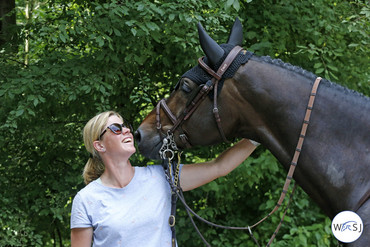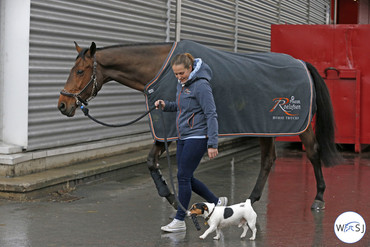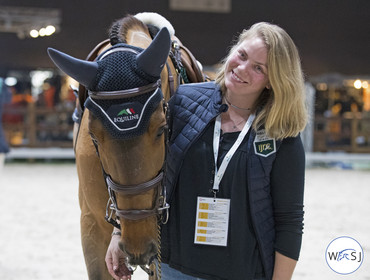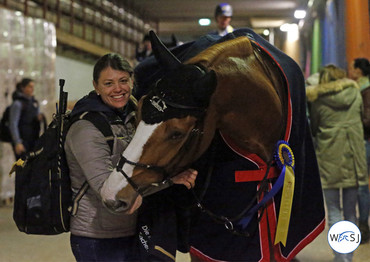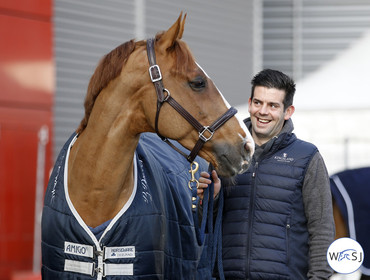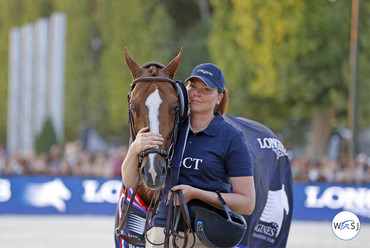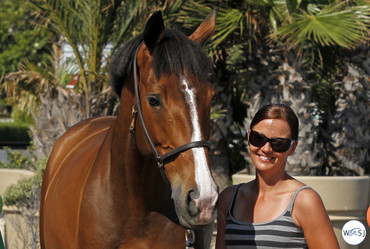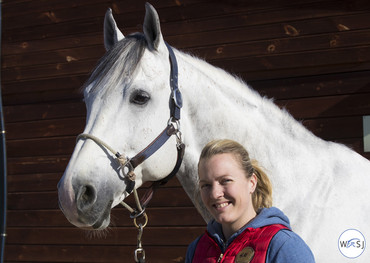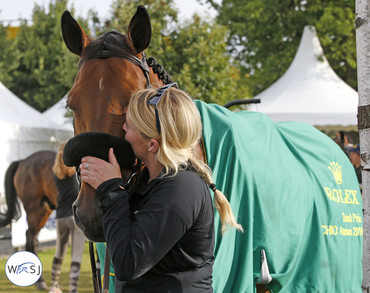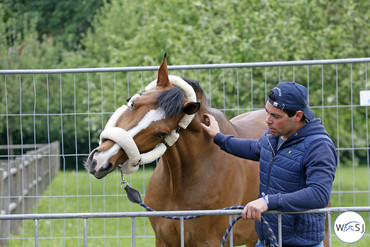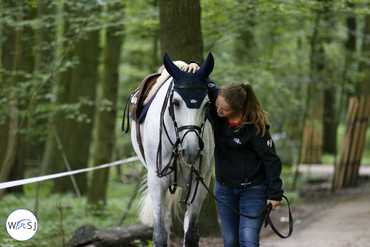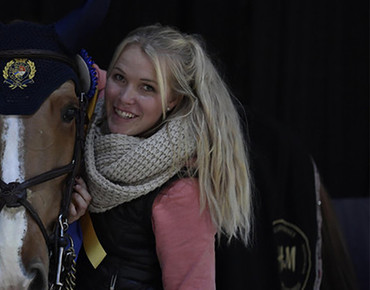Text © World of Showjumping
How can you best care for your horse? World of Showjumping asked several highly experienced grooms to share their tips & tricks. In the third part of this series, the focus is on leg care.
Fran Callan, long-time groom for Jur Vrieling:
“Simple is always best. When it comes to the horse’s legs, I am a firm believer in just feeling the legs daily. Learning each and every horse’s lumps and bumps, scabs and scars. You need to know the normal for each horse, and then you become aware of the abnormal when/if it happens. This means you can target the problem a lot quicker if there is heat or swelling.
We only ice after a horse has jumped. EquiFit is in my opinion the best brand on the market and we use their ice boots. They are incredible and offer a knee to floor boot. This keeps the legs cool right through to the foot, which many other ice boots do not. The legs feel so cool when they come out of the boots and it has helped hugely after jumping or for horses that are on rehabilitation work. EquiFit boots never rub, and have a three-strap design which I love as I find it supporting the fetlock joint. I find a lot of boots leave the fetlock very open and loose and not supporting of this joint. This therefore increases damage, rubs and friction burns.
We also use Traumeel gel, which is a great product that works directly, and effective every time – for the rest we keep it simple.
Bandaging is something I really feel is good for the horses when competing or after a super hard training session. But it has to be done properly, a bad bandage could be worse than not bandaging at all. For me every horse is different, so on the whole I bandage according to each horse’s needs. For example, some horses in our stable hate having bandages on behind, some pull bandages off in front."
Madeleine Broek, long-time groom for Marc Houtzager:
“After jumping I put cold packs on the legs to make sure the tendons cool down and the blood circulation goes on. We also have an Equitron machine for high energy cell therapy. When it comes to bandages, some of our horses have bandages on over the night.”
Morgane Tresch, long-time groom for Jeroen Dubbeldam:
“You have to keep an eye on the legs of your horses all the time; you are the only one to see if everything is in order. Every morning I check the legs of my horses, so they don’t have a big leg or a cut – you never know what can happen in the night. After work, we cool the legs down with cold water and dry it good with towels. You can also use baby powder to help to dry the legs.
If your horse has got a big leg, cool it down with cold water and walk on a hard ground, which is better for the blood circulation than a soft ground. You can then use a mix with Tendonil and Traumeel.
I use stable bandages only after jumping and on the show horses. At home I basically use Tendonil and Traumeel on the legs and at the show I also use Uptite as well as bandages.”
Nickki O’Donovan, long-time groom for Darragh Kenny:
“Less is more. I like to ice after jumping and bandage with Traumeel over-night. On a day-to-day basis, the legs are left natural. I will clay the legs after jumping a bigger track or after a few days jumping in a row.
I only bandage after jumping, or if I notice that a horse had a slightly puffy leg one day – then I will bandage overnight. But I don’t believe in bandaging all the time. If you bandage all the time without having any problem with a leg, where do you go from there?”
Kay Neatham, former long-time groom for Marcus Ehning:
“The most important thing to know about leg care is the legs – seriously, study them, read books about them, ask vets to explain, look at x-rays and MRIs. In my opinion nothing is more important about the legs than knowing what is normal for each individual horse and when by each individual horse your alarm bells should ring. It is absolutely essential with new horses to get to know their legs fast.
In the morning by feeding, run a hand down as well as before and after work. I always knew immediately if an area even was a fraction warmer. I bugged people about legs and my feeling that something wasn’t quite right.Try different things, just because Uptite works well over-night on one horse’s legs does not mean that will be best for the next horse. Gels, creams, combinations of both or different types of all work for each horse individually. So try different things and see what the legs feel like the next morning – stay open minded!
Of course the most important thing for legs is movement, a little filling in the morning after a hard days work can be gone in the blink of an eye with a little walk out. Horses were naturally made to move for nearly 24hrs a day, evolution is not that fast and this is still in my opinion the biggest one major factor in keeping legs in good condition. Walk, walk and more walk!”
Sean Lynch, long-time groom for Daniel Deusser:
“I try not to do too much; no point to fix something if it isn’t broken. But I will ice most horses after jumping. Traumeel gel is the only product I use; it’s simple and effective.
I’m a big bandage guy though! Every horse at the show will be bandaged. Some horses are different – for instance Scuderia 1918 Tobago Z and Calisto have bandages on all four legs after jumping where as Killer Queen VDM and Jasmien vd Bisschop only have in front. I have tried many times to put back bandages on them and they never accept it, so I think it depends on the horses. And on the shows I like to use Back on Track stable boots for the daytime, as they are the best I ever used.”
Marlen Schannwell, long-time groom for Bertram Allen:
“Don’t try to cure problems you don’t have. If you ice, poultice and bandage every day, what will you then do on Sunday after your horse jumped two rounds in a 1.60m class or got an injury?
Every horse has different needs, so I go after what they have done that day and what helps that horse – not every horse reacts good on poultice or ice. Icing only makes sense straight after they jumped – if you go to wash and walk first, it doesn’t make much sense anymore.
I’m not a big fan of poultice since I believe it only has a benefit to the horse while it’s wet and actually cools the legs – as soon as it’s dry, it dries out the skin and is uncomfortable. So, if I clay, then it’s just during the day so I can wash it off and repeat if necessary.
We use a lot of spa-boots or big rubber buckets with ice water and Epsom salt and let the horses stand in there for 20-30 minutes. They are curios the first few times, but will love it.
If there is no reason – like swelling, injury etc. – we don’t use stable bandages. After jumping big classes, some horse will get bandages with poultice, zinc bandages or Tendonil. However, I don’t believe in bandaging just because it’s a sport horse since so much can go wrong with too warm legs or too tight bandages. Sure, if the horse is crazy kicking the walls then it will get bandages for protection – but I don’t think it helps the blood and lymph flow to have them bandaged every day and night."
Heidi Mulari, long-time groom for Steve Guerdat:
“Washing the legs is a whole other story than the body… I think we have all been in Spain or Florida with horses with scabby legs. It has to do with different bacteria in the soil and so on. In these places I avoid washing the legs, but if needed then only with water. Shampoo, or even worse Betadine shampoo, takes away the natural grease and then the skin breaks easier. Drying the legs well afterwards is also crucial. The longer they stay wet the worse. Baby powder helps a lot too. If anyhow I get scabs on the legs, I apply some anti-inflammatory cream – for example Flammazine; wrap it with the plastic-like paper from a feedbag and bandage over night.
I use stable bandages if needed, for example if a horse has a previous health problem or it has done a significant work-out. I don’t see any point to keep them wrapped-up in cotton and let them get used to bandages – I think there always has to be something extra left. I mean, I don’t think a healthy horse needs to be iced, poulticed and bandaged after every time jumping. If all these ”resources” are already used, what are we supposed to do after jumping a 1.60m course on a dodgy ground? For this reason I also keep the leg care after jumping very simple for the young horses. What doesn’t kill them, makes them stronger.”
Malin Henlöv, long-time groom for Peder Fredricson:
“We keep it simple. Horses that get swollen legs or for any other reason need a bandage over night get it, but if not they stay without. Older horses get bandages after competing or jumping a lot at home. The younger horses I try to keep without stable bandages as long as I can.”
Denise Moriarty, long-time groom for Kent Farrington:
“The leg care very much depends on the horse, previous injuries and level of work. Our go-to products are arnica, Tendonil and poultices. At the shows I like to use Back on Track Quick Wraps during the day to keep the circulation going, especially with the older horses.
I don’t tend to bandage the horses everyday at home. At the show we do as it is an unfamiliar place for the horses and it can often be busy and noisy which can make the horses restless.”
Sean Vard, long-time groom for Martin Fuchs:
“As like with the hoofs we don’t wash too much so the legs tend to stay muck/crust free. Again; good brushing is essential. I personally like when the legs are not too hairy so if a situation does occur – muck, dry skin, injuries, wounds – I can see it immediately and tend to it before it becomes something greater. Also I believe the horses’ look sharper and more polished!
After jumping our older horses at home, we ice and use our homemade clay overnight. It’s an old-school Fuchs remedy that has worked for years, so I would be a fool should I try to change it. It has worked well for me during the past four years.”
Aurelie Marchiando, long-time groom for Leopold van Asten:
Josie Eliasson, long-time groom for Jessica Springsteen:
“Even though I prefer not to wash my horses so much, I do however always wash their legs off properly in Florida since it is so easy to get skin infections there. If my horses would get a rash I like to use Witch Hazel spray, this is one of the things that we always bring back with us from America since it doesn’t exist in Europe.
It is very common with skin reactions on the legs in Florida. I find “sweating out” a good method for that. I would typically put Furacin cream, put some thin plastic around the leg and then wrap it. I would keep doing this for a couple of days without washing the legs, only switch to work bandages for exercising. I would also normally start the horse on SMZ (Sulfamethoxazole) tablets, which is a mild antibiotic. It works wonders and is show safe.
I believe in bandaging horses with stable wraps, if done correctly. I always bandage straight after jumping no matter where in the world I am. If a horse has an old injury, a problem area or just a tendency to get big and puffy in a leg I like to wrap them over night. However, if a horse is not comfortable with bandaging I think it can do more harm than good.”
No reproduction without written permission, copyright © World of Showjumping



